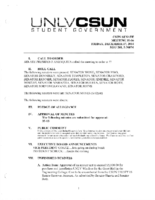Search the Special Collections and Archives Portal
Search Results

Lisa Song Sutton oral history interview: transcript
Date
Archival Collection
Description
Oral history interview with Lisa Song Sutton conducted by Cecilia Winchell, Vanessa Concepcion, and Stefani Evans on November 19, 2021 for Reflections: The Las Vegas Asian American and Pacific Islander Oral History Project. Lisa shares her personal history and childhood memories moving from Seoul, South Korea to Sierra Vista, Arizona at the age of five. She discusses her educational and professional pursuits in business litigation, bankruptcy law, entrepreneurship, modeling, and her time in the pageant circuit winning Miss Vegas and Miss Nevada in 2013. Lisa also talks about her activism and community engagement efforts to empower women within Las Vegas. She concludes her interview with insight into her Korean heritage, traditional celebrations, and religion.
Text
Rinker, C. A. Earle (Cleveland A. Earle), 1883-1965
Cleveland A. Earle Rinker was born in Indiana in 1883 to S. Cleveland Rinker and Isadora (Fenwick) Rinker. Shortly after his twentieth birthday Rinker went to Parker, Indiana, seeking work as a stenographer. He soon began working as a clerk for Thomas Condon, a coal and oil dealer who was also an enthusiastic investor in Nevada gold mines. Condon encouraged Rinker to seek his fortune in the gold fields and, in late October of 1906, Rinker boarded a train to make the journey to Goldfield, Nevada.
Person
Hooper, Robert Scott
Robert Scott Hooper, was an artist and photographer based in Las Vegas, Nevada who photographed diverse subjects over many decades. His work has been seen on the pages of newspapers and magazines worldwide, from Life to the cover of Playboy; featured on billboards, posters, postcards, phone cards and video game machines; and exhibited in galleries and private collections. He won numerous awards for his creations in graphic arts, commercial television production, advertising, print work, and even photographing a centerfold for Playboy.
Person
Juanita Greer White Photographs
Identifier
Abstract
The Juanita Greer White Photographs (approximately 1960-1979) depict Dr. Juanita Greer White’s activities in politics and higher education in Southern Nevada. Images depict Dr. Greer White receiving a Distinguished Nevadan Award, acting as a Nevada Delegate for the National Conference on Aging, and her time spent in the Nevada State Legislature.
Archival Collection
Nevada Women’s Conference Photograph Collection
Identifier
Abstract
The Nevada Women’s Conference Photograph Collection depicts the statewide women’s conference held in June 1977 in Las Vegas, Nevada. The photographs include keynote speaker Gloria Steinem, event organizers, workshops, volunteers, and musical performances.
Archival Collection
Grace Hayes Papers
Identifier
Abstract
The Grace Hayes Papers (1900-1989) include personal papers and financial papers pertaining to the Grace Hayes Lodge (formerly the Red Rooster), a nightclub on the Strip in Las Vegas, Nevada. The collection includes financial documents, newspaper clippings about Hayes and her family, personal correspondence, career mementos, legal documents, and photograph albums.
Archival Collection
Dennis and Roberta Sabbath Papers
Identifier
Abstract
The Dennis and Roberta Sabbath papers are comprised of photographs, newspaper clippings, and ephemera created and collected by Dennis and Roberta Sabbath. Photographs and ephemera document the Sabbaths' personal and social lives and their involvement in the Jewish community in Las Vegas, Nevada. Newspaper clippings document the law career of Dennis Sabbath and his campaign for Nevada State Senate in 1986.
Archival Collection
Edith Giles Barcus Family Photograph Collection
Identifier
Abstract
The Edith Giles Barcus Family Photograph Collection (approximately 1878-1954) consists of black-and-white photographic prints and negatives, as well as postcards and photograph albums. The images depict locations in Nevada including Las Vegas, Goldfield, Searchlight, and Tonopah, in addition to locations in Arizona, California, Colorado, Massachusetts, Utah, and Mexico. Also included are images of family, friends, and associates of the Giles Barcus family. The albums contain photographs depicting the Giles family as they traveled through the southwest United States and Mexico, as well as postcards from prominent locations in the southwestern United States.
Archival Collection

Meeting minutes for Consolidated Student Senate, University of Nevada, Las Vegas, December 17, 2004
Date
Archival Collection
Description
Text
